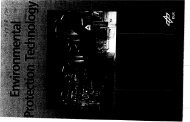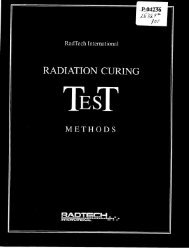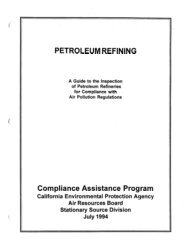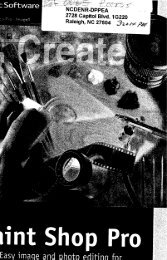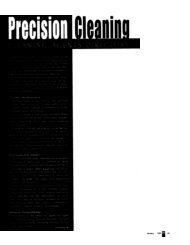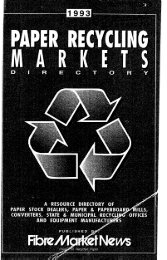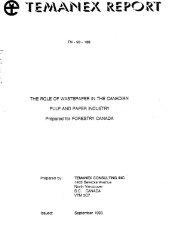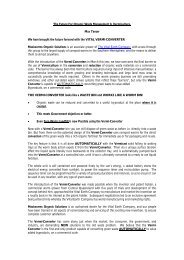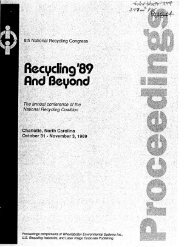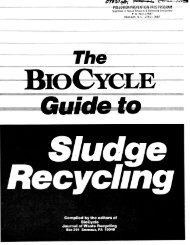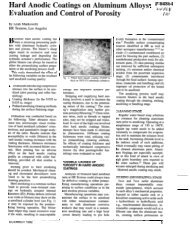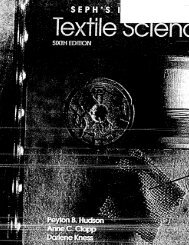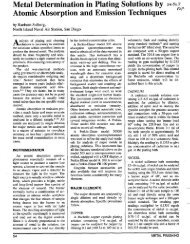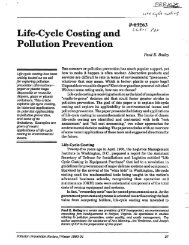Electronic Parts/Guidelines - infoHouse
Electronic Parts/Guidelines - infoHouse
Electronic Parts/Guidelines - infoHouse
You also want an ePaper? Increase the reach of your titles
YUMPU automatically turns print PDFs into web optimized ePapers that Google loves.
Recyc/eb///ty: Corrugated fiber board is a highly desirable material for recycling. There are extensive<br />
systems set up throughout the country for collecting and recycling corrugate board. 9.098,oOO tons of<br />
corrugated was recycled in 1991, an increase of 4.2% from the previous year. The trend IS for greater<br />
increases in 1992.<br />
/nc/n.rstlon: Corrugated can be incinerated, prodUChg 7080 Btu/pound. but is not as efficient as fossil<br />
fuel energy generation. Refer to Table 11 on page 63 for energy content of other materials.<br />
Com~~~//ltylBlodegmd~b///~~: COrrUgated fiber board is generally biodegradable (except for<br />
chemically treated and/or waxed board). However, like other "degradable" materials in a landfill,<br />
Corrugated may take many years to break down due to lack of oxygen and light. When shredded,<br />
corrugated fiberboard is a very good compost material.<br />
7.5.1.4 Recommendations: Companies purchasing Corrugated containers can request informa-<br />
tion on environmental stewardship practice from their suppliers. Many large milis have wildlife pro-<br />
tection practices, pollution control practices, high recycled content and policies on harvesting old<br />
growth forests. By requesting this information and using this as a basis for deciding a vendor, the<br />
electronics packaging professional can have a positive impact on improving policies for companies<br />
that do not have an environmental stewardship policy and rewarding companies that do.<br />
Recycled content is commonly available with minimal effect on strength and appearance. For many<br />
uses like pads, partitions and void fillers, virgin material is not necessary and lM)% recycled board<br />
would work weii. Even outer shipping containers can utilize the 100% recycled material with little<br />
degradation in performance. By specifying recycled content (a mixture of post-consumer and industrial<br />
scrap) the packaging professional can have a positive impact on the market for collecting corrugated<br />
fiber board and reducing the amount of trees needed for the industry.<br />
The printing inks for some containers have used heavy metals. Current legislation in the Northeast<br />
United States will require a combined maximum of 100 parts per miiiion (ppm) by weight of lead,<br />
cadmium, mercury, and hekavaient chromium for any packaging material. A good practice would be to<br />
requesting that the inks be FDA approved or contain no more than 100 ppm of heavy metals.<br />
7.5.2 Environmental lmpad of Polystyrene<br />
Polystyrene is the oldest commercial thermoplastic polymer resin, having been commercially produced<br />
at the beginning of World War II. It is stable, lightweight. an excellent thermal insulator, water<br />
reslstant, and ideal for cushioning when expanded (foamed). Polystyrene has multiple uses.<br />
Expanded, it is used in the food service industry as container materials and in the electronics industry<br />
as cushioning for delicate instrumentation. It is also used in toys, housewares, and office supplies<br />
Polystyrene resins sales in the U.S. in 1990 were 5.1 billion pounds of which approximately 250 mlilion<br />
pounds was EPS from packaging.<br />
7.5.2.1 Resources: Polystyrene Is a derivative of benzene and ethylene; both by- products of the<br />
production of oil and gas, which are non-renewable resources. It is estimated that approximately 3%<br />
of oil and natural gas volume is used by the plastics industry. A specific percentage for polystyrene IS<br />
not available. Environmental impacts of oil and gas drilling for energy would be similar to those for the<br />
plastic industry, and include the extractive operations on sensitive habitats and general depletion of<br />
the fossil fuel base.<br />
7.5.2.2 Manufacturing<br />
Energy Use: Because it involves high temperature processes, some of which exceed 600' C, the man-<br />
ufacture of styrene and polystyrene requires high energy inputs. This is somewhat offset by the<br />
recovery of steam and other process byproducts which are reconverted to energy for the processes.<br />
Life Cycle Assessment 59



